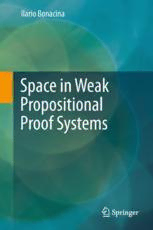Table Of ContentIlario Bonacina
Space in Weak
Propositional
Proof Systems
Space in Weak Propositional Proof Systems
Ilario Bonacina
Space in Weak Propositional
Proof Systems
123
Ilario Bonacina
Departament deCiències dela Computació
Universitat PolitècnicadeCatalunya
Barcelona
Spain
ISBN978-3-319-73452-1 ISBN978-3-319-73453-8 (eBook)
https://doi.org/10.1007/978-3-319-73453-8
LibraryofCongressControlNumber:2017963852
©SpringerInternationalPublishingAG,partofSpringerNature2017
Thisworkissubjecttocopyright.AllrightsarereservedbythePublisher,whetherthewholeorpart
of the material is concerned, specifically the rights of translation, reprinting, reuse of illustrations,
recitation, broadcasting, reproduction on microfilms or in any other physical way, and transmission
orinformationstorageandretrieval,electronicadaptation,computersoftware,orbysimilarordissimilar
methodologynowknownorhereafterdeveloped.
The use of general descriptive names, registered names, trademarks, service marks, etc. in this
publicationdoesnotimply,evenintheabsenceofaspecificstatement,thatsuchnamesareexemptfrom
therelevantprotectivelawsandregulationsandthereforefreeforgeneraluse.
The publisher, the authors and the editors are safe to assume that the advice and information in this
book are believed to be true and accurate at the date of publication. Neither the publisher nor the
authorsortheeditorsgiveawarranty,expressorimplied,withrespecttothematerialcontainedhereinor
for any errors or omissions that may have been made. The publisher remains neutral with regard to
jurisdictionalclaimsinpublishedmapsandinstitutionalaffiliations.
Printedonacid-freepaper
ThisSpringerimprintispublishedbytheregisteredcompanySpringerInternationalPublishingAGpart
ofSpringerNature
Theregisteredcompanyaddressis:Gewerbestrasse11,6330Cham,Switzerland
tomyfamily
Preface
Inthisbookyou,thereader,aregoingtoseesomeresultsonthespacecomplexityof
somepropositionalproofsystems.ThisbookisarevisedversionofmyPhDthesis1
andindeeditisnotintendedtobeasurveyofalltheresultsknownonthespace
complexityofpropositionalproofsystems.Itwillratherbealongwalktouching
sometopicsinproofcomplexity,mostlyaboutspaceofcourse,butnotexclusively.
Hopefullythiscouldbeusedtooasaratherreader-friendlyexpositionofsomegame
theoreticmethodsusedinproofcomplexity.Thisisindeedanundergroundtheme
connectingmostoftheresultsweshow.Ofcoursetherewillbesomesurvey(-ish)
partsbutmainlythefocuswillbeonthenewgametheoretictechniquesandtheir
applicationtotheanalysisofthespacecomplexityofpropositionalproofsystems.
That is the results arising from my PhD thesis [Bon15] and some earlier works
+
[BG13,BGT14,BT15,BG15,BBG 17,BT16a,BT16b,BGT16,Bon16].
Thisisaworkaboutproofcomplexity,solet’sstartbyintroducingitinformally.
Proofcomplexityisaresearchareathatstudiestheconceptofcomplexityfromthe
pointofviewoflogic.Inparticular,inproofcomplexityweareinterestedinquestions
suchas:“howdifficultisittoproveatheorem?”Or,moreprecisely,givenaformal
system,weareinterestedinmeasuringthecomplexityofatheorem,thatisanswering
questionssuchas“whatistheshortestproofofthetheoreminagivenformalsystem?”
Thismirrorsquestionsincomputationalcomplexityabout,forexample,thenumber
ofstepsthataTuringmachineneedstocomputeagivenfunction f;orthesizeof
circuitsneededtocompute f.2
Inthisbookweinvestigatethespacecomplexityofpropositionalproofsystems,
sowhatisthespaceofaproof?Wecouldstatethisquestionpictoriallyas“what
isthesmallestblackboardateacherneedstopresenttheproofofatheoremtoa
class of students?”3 As before, this notion is analogous to the space complexity
1Thisrevisedversionisduetothefactthatmythesiswasawarded“BestItalianPhDThesisin
TheoreticalComputerScience”fortheyear2016bytheItalianchapteroftheEuropeanAssociation
forTheoreticalComputerScience(EATCS).
2Ontheotherhand,wecouldalsomeasurethecomplexityofatheoremasthestrengthofatheory
neededtoprovethetheorem.Thisalsohasacounterpartincomputationalcomplexity,itislinked
withquestionsaboutthesmallestcomplexityclasstowhichagivenfunctionbelongs.
3Wesupposeherethatthestudentscanunderstandjustproofswrittenontheblackboardinsome
given formal system and they do not have any additional memory except the minimal one to
vii
viii Preface
in the context of uniform computations, measured, for example, as the size of a
working-tapeneededbyaTuringmachinetocomputeagivenfunction.
Propositionalproofcomplexity,thatisthecomplexityofpropositionalproofs,
plays a role in the context of feasible proofs as important as the role of Boolean
circuitsinthecontextofefficientcomputations.Althoughtheoriginalmotivationsto
studythecomplexityofpropositionalproofscamefromproof-theoreticalquestions
aboutfirst-ordertheories,itturnsoutthat,essentially,thecomplexityofpropositional
proofs deals with the following question: “what can be proved by a prover with
boundedcomputationalabilities?”Forexample,ifitscomputationalabilitiesarelim-
itedtosmallcircuitsfromsomecircuitclass.Hence,propositionalproofcomplexity
mirrorsnon-uniformcomputationalcomplexityandindeedthereisaveryproductive
cross-fertilizationoftechniquesbetweenthetwofields.Ourunderstandingofpropo-
sitionalproofsystemsis,unfortunately,similartothegeneralsituationincomplexity
theory.Inbothfieldswecanprovelowerboundsinveryspecialcasesandindeed
thereareseveralmajoropenproblemsthatareverybasic,waymorebasicthanthe
well-knownquestionP=? NP.Thesituationissimilarinthesensethatwecanprove
super-polynomial lower bounds on the length of proofs only for restricted proof
systems.Indeed,byaresultof[CR79],provingsuper-polynomiallowerboundson
thelengthofproofsforeverypropositionalproofsystemisequivalenttoshowing
thatNP(cid:2)=coNP,whichinturnisoneoftheopenandveryimportantproblemsin
computationalcomplexity.Propositionalproofcomplexityisimportantalsofrom
thepracticalpointofview.Theimplementationsofstate-of-the-artSATalgorithms
ultimately rely on rather simple propositional proof systems. Hence the study of
thosesystemshelpsinclarifyingthelimitationsofsuchalgorithmsthatareessential
invariousaspectsofcomputerscience,cf.[Nor15].
Wewillfocusonthespacecomplexityoftwoparticularproofsystems:resolution,
awellstudiedproofsystemthatisatthecoreofstate-of-the-artSAT-solvers;and
polynomialcalculus,aproofsystemthatusespolynomialstorefutepropositional
formulasthatarecontradictions.Wewillshowsomegenericcombinatorialtechniques
to prove space lower bounds in both those systems and then we will apply those
techniquestoshowconcretespacelowerboundsforrefutationsofseveralparticular
(unsatisfiable) propositional formulas. Since the very first exponential size lower
bound for resolution size in [Hak85], game theoretic methods and combinatorial
characterisationsofhardnessmeasureshavealonghistoryinproofcomplexity.This
bookcouldbeseenasthelatestcontributiontothistopic.
For resolution the new techniques we introduce allowed for the first time to
obtain—inaquiteeasywayactually—lowerboundsforthespaceofproofswhenthe
spaceismeasuredasthetotalnumberofvariablestobekeptinmemory(totalspace).
Forpolynomialcalculusthetechniquesweintroduce—whichismoreinvolvedthan
thoseforresolution—allowustoaddressspacelowerboundswhenthespacetakes
into account the number of distinct monomials to be kept in memory (monomial
space).Notablythosetechniquesallowustoprove,amongotherresults,thatalmost
understandthecontentoftheblackboard.Moreovertheteacherhastowritewithfontsofafixed
size.
Preface ix
allk-CNFformulasarehardwithrespecttototalspaceinresolutionandmonomial
spaceinpolynomialcalculus.Thatisweproveasymptoticallyoptimallowerbounds
forthemonomialspace(andtotalspaceinresolution)forrandomk-CNFformulas
innvariablesandalinearnumberofclauses.Thiswasanopenproblemmentioned
for the first time in [BS01, ABRW02] and since then reported many times in the
literature.
BookStructureAfteranintroductiontopropositionalproofcomplexity(Chap.1),
this work consists of 3 parts. Each chapter ends with a section containing open
questionsandaHistorysectioncollectingsomefactsaboutthemaintheoremsof
thechapterandhowtheyfitinthepreviousliterature.
In Part I there are two chapters on resolution: one containing results already
knownintheliteraturebeforethiswork(Chap.2)andonejustfocusedonspacein
resolution(Chap.3).Morepreciselyonthecombinatorialtechniquestoprovetotal
spacelowerbounds.Thenwemovetopolynomialcalculusanditsspacecomplexity
(Chap.4).Thefocuswillbenowonthecombinatorialtechniquetoprovemonomial
spacelowerbounds.
InPartIIwecollectthemainapplicationsofthetechniqueswebuiltpreviously.
Firstthereisashortchapterabouttheproofcomplexityandspacecomplexityofthe
pigeonprinciples(PHPmanditsvariations),cf.Chap.5.Thenthereisaninterlude
n
onsomenewtypeofgames,thecovergames,definedonbipartitegraphs(Chap.6).
Thischapterisessentiallyindependentfromtherestofthebookanditcollectssome
resultsongraphtheory.Themotivationbehindthischapterthoughisthattheresults
initwillbeneededinChap.7toprovethespacelowerboundforrandomk-CNF
formulasandothergraph-basedpropositionalformulas.
Inthelastpart,PartIII,weanalysethesizeofresolutionproofsinconnection
withtheStrongExponentialTimeHypothesis(SETH)incomplexitytheory.More
preciselyweprovestrongsizelowerboundsforarestrictedversionofresolutionwe
callδ-regularresolution.Althoughnotdirectlyrelatedtospace,theresultsweshow
hererelyonsomecombinatorialcharacterisationsandgamesanalogoustotheone
usedtoprovespacelowerbounds.
AcknowledgmentsFirstofall,IwanttothankmyadvisorNicolaGalesiatSapienza
UniversityofRome.Hecultivatedmyinterestinproofcomplexitysupportingthe
goodideasandshootingdownthe(many)buggyones.Thisbooksimplywouldn’t
haveexistedwithouthim.
Iamtrulygratefultothemanypeoplefromtheproofcomplexitycommunitythat
Ihadtheprivilegetomeet.Myviewofproofcomplexityandtheoreticalcomputer
sciencewasshapedbyallofthediscussionswehad.InparticularIwanttothank
(theorderisnotrelevanthere):JakobNordström,MassimoLauria,MladenMikša,
MarcVinyals,SusannaFigueiredodeRezende,NavidTalebanfard,TonyHuynh,
Paul Wollan, Pavel Pudlák, Jan Krajícˇek, Neil Thapen, Olaf Beyersdorff, Rahul
Santhanam,AlbertAtserias,JacoboTorán,andYuvalFilmus.
Stockholm, IlarioBonacina
May31,2017
Contents
1 Introduction................................................... 1
1.1 PropositionalProofSystems ................................. 1
1.1.1 FregeSystems....................................... 3
1.1.2 AlgebraicProofSystems.............................. 5
1.1.3 GeometricProofSystems ............................. 8
1.1.4 ConnectionwithSAT-Solvers.......................... 8
1.2 SpaceofProofs ............................................ 10
1.3 SummaryofResults ........................................ 11
PartI GeneralResultsandTechniques
2 Resolution..................................................... 15
2.1 SubsystemsofResolution ................................... 15
2.2 Size...................................................... 16
2.3 WidthandAsymmetricWidth ................................ 20
2.3.1 CombinatorialCharacterizations ....................... 23
2.3.2 The“Equivalence”ofWidthandAsymmetricWidth....... 26
2.4 OpenProblems ............................................ 28
3 SpaceinResolution ............................................ 29
3.1 SemanticResolution ........................................ 30
3.2 ClauseSpace .............................................. 31
3.2.1 SemanticClauseSpace ............................... 33
3.3 TotalSpace................................................ 34
3.3.1 SemanticTotalSpace................................. 36
3.4 SpaceandDepth ........................................... 38
3.5 OpenProblems ............................................ 39
4 SpaceinPolynomialCalculus.................................... 41
4.1 FromCNFFormulastoPolynomials .......................... 42
4.1.1 CompleteTreeFormulasCT .......................... 44
n
xi
xii Contents
4.2 SizeandDegree............................................ 44
4.3 Space .................................................... 45
4.4 SemanticPolynomialCalculus ............................... 47
4.5 MonomialSpaceLowerBounds .............................. 48
4.5.1 CT RequiresLargeMonomialSpace ................... 51
n
4.5.2 ProofsofTheorem4.2andTheorem4.3 ................ 52
4.6 OpenProblems ............................................ 56
PartII Applications
5 PigeonholePrinciples........................................... 61
5.1 The(Standard)PigeonholePrinciples.......................... 61
5.2 TheBit-PigeonholePrinciple................................. 65
5.3 TheXORPigeonholePrinciple ............................... 67
5.4 OpenProblems ............................................ 69
6 Interlude:CoverGames ........................................ 71
6.1 C-Matchings............................................... 71
6.2 SomeHall’sTheorems ...................................... 72
6.2.1 AHall’sTheoremforVW-Matchings ................... 73
6.3 CoverGames .............................................. 75
6.4 RandomBipartiteGraphs.................................... 77
6.5 WinningStrategiesforCoverGames .......................... 79
6.5.1 AWinningStrategyfortheGameonV-Matchings ........ 79
6.5.2 AWinningStrategyfortheGameonVW-Matchings ...... 83
7 SomeGraph-BasedFormulas ................................... 89
7.1 FromCoverGamestoSpaceLowerBounds .................... 89
7.2 Randomk-CNFFormulas ................................... 92
7.3 PigeonholePrinciplesoverGraphs ............................ 95
7.4 TseitinFormulas ........................................... 97
7.5 OpenProblems ............................................100
PartIII APostlude
8 StrongSizeLowerBoundsfor(aSubsystemof)Resolution .........105
8.1 SETHandProofComplexity.................................105
8.2 GameCharacterizationsofWidthandSize .....................108
8.3 AStrongWidthLowerBound................................113
8.4 OpenProblems ............................................ 117
References.........................................................119
Index .............................................................129

